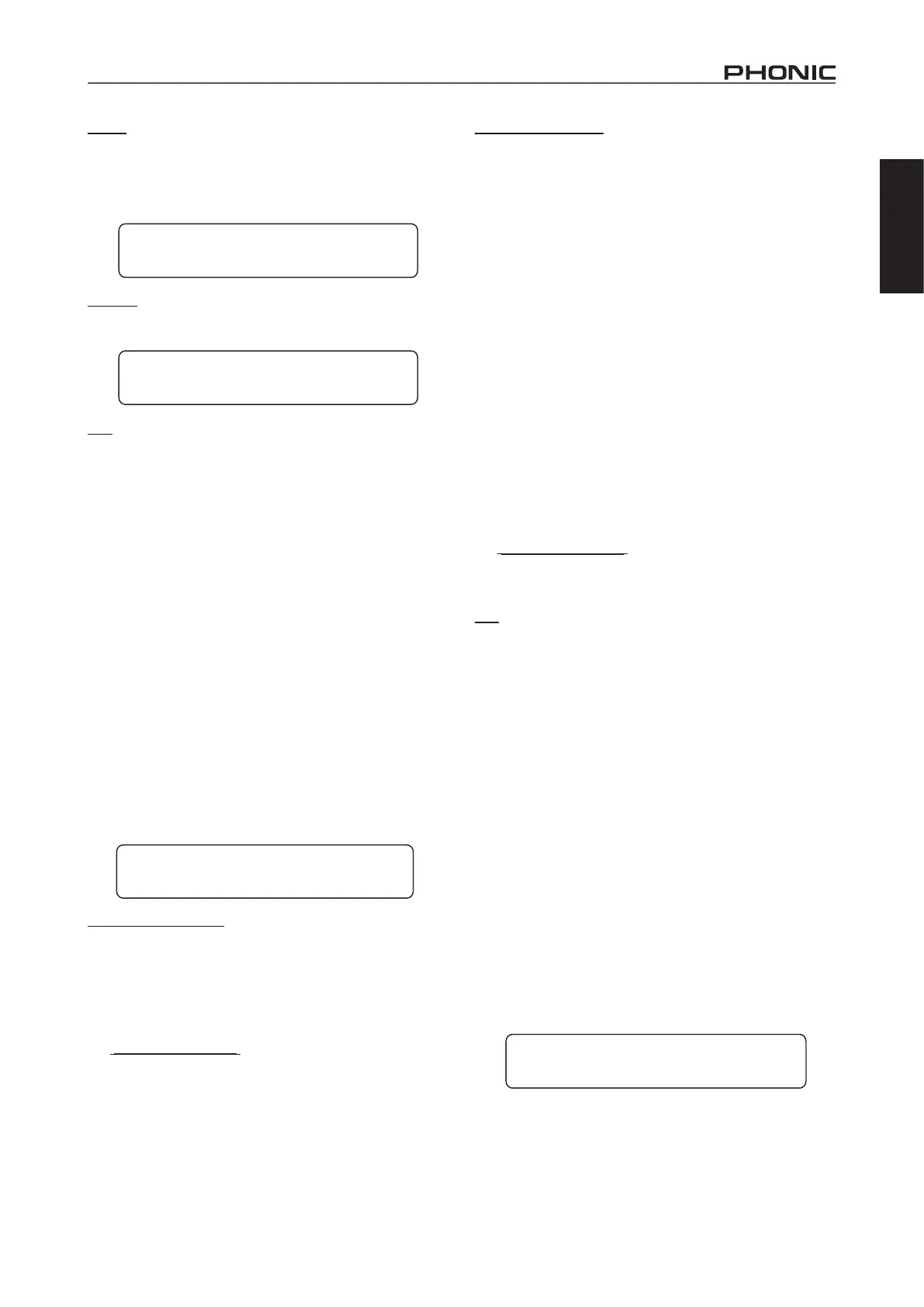Phonic i2600 handleiding
Handleiding
Je bekijkt pagina 23 van 62

19
i2600
English
Delay – on this page it is possible to set the Output Channels
Delay Time from 000.0000mS up to 598.998ms, by steps of 1mS
or 20.8uS. As with most functions, pushing the ENTER button will
bring up the arrow () and the PM2 and PM3 encoders can be
used to adjust the delay time in steps of 1 millisecond and 20.8
microseconds, respectively.
Polarity – from this page it is possible to set the Output Channel
Polarity, by using the PM2 or PM3 encoders. The polarity can be
“Normal” or “Inverted” (ie. rotated of 180 degrees).
HPF – from this sub-menu it is possible to set the Output Channel’s
High Pass Filter. After pressing the ENTER button, the lter type
elds and the Cutting frequency elds become accessible to the
user. The available shapes and orders for the High Pass Filter,
accessible by rotating the PM2 encoder, are listed below:
• Bypass (High Pass Filter Bypassed)
• Buttw_1st (Butterworth Filter 6dB/Oct Slope)
• Buttw_2nd (Butterworth Filter 12dB/Oct Slope)
• LRiley_2nd (Linkwitz/Riley Filter 12dB/Oct Slope)
• Bessel_2nd (Bessel Filter 12dB/Oct Slope)
• Buttw_3rd (Butterworth Filter 18dB/Oct Slope)
• Buttw_4th (Butterworth Filter 24dB/Oct Slope)
• LRiley_4th (Linkwitz/Riley Filter 24dB/Oct Slope)
• Bessel_4th (Bessel Filter 24dB/Oct Slope)
• Custom_2nd (IInd Order Filter Cell with editable Cutting
Frequency and Q)
• Custom_3rd (Cascade of two 2nd Order Filter Cells with
editable Cutting Frequency on both and Q on the second
one)
• Custom_4th (Cascade of two 2nd Order Filter Cells with
editable Cutting Frequency and Q on both of them)
HPF [Standard Filters] – from this sub-menu, using the PM2
encoder, it is possible to set the HPF to bypass or as one of the 8
standard lters: Buttw_1st, Buttw_2nd, LRiley_2nd, Bessel_2nd,
Buttw_3rd, Buttw_4th, LRiley_4th, Bessel_4th. The lter's
frequency can be set within this editing page using the PM3
encoder in 1 Hz steps (for ne turning). For greater control of the
low cut frequency setting, push the ENTER button to access the
frequency setting page.
“Low Cut Frequency”: the selectable frequency range is
from 20Hz to 20kHz. Use the NAV/PM1 encoder to increase /
decrease the frequency in steps of 1000Hz, the PM2 in steps
of 100Hz and the PM3 by steps of 1Hz.
HPF [Custom Filters] – from the HPF sub-menu page, using
the PM2 encoder, it is also possible to set the HPF as a “Custom
Filter”. This means that the HPF is built as cascade of 2nd Order
Cells with varying user-denable parameters. The available
independent parameters for each custom preset are as follows:
• Custom_2nd: Uses 1 2nd order Cell, where Low Cut
Frequency and Q can be set.
• Custom_3rd: built using 1 3rd order Cells, where Low
Cut Frequency can be set on both the cascaded Cells
and the Q on the second one
• Custom_4th: built using 2 2nd order Cell, where Low
Cut Frequency and the Q be set on both the cascaded
Cells.
From this Page, to access the cascaded 2nd order Cells, it
is necessary to rotate the NAV/PM1 encoder Clockwise or
Counterclockwise. The number of accessible 2nd order Cells is
dependent on the Custom Filter order: Custom_2nd will allow the
editing of just one 2nd order Cell, Custom_3rd and Custom_4th,
the access to two 2nd order Cells.
Rotate the NAV/PM1 encoder clockwise to access the Filt1 (Cell1)
and Filt2 (Cell2) pages. This gives direct access to each Cell’s Low
Cut Frequency and Q settings. The lter's frequency can be set
within this editing page using the PM3 encoder in 1 Hz steps (for
ne turning). For greater control of the low cut frequency setting,
push the ENTER button to access the frequency setting page.
“Low Cut Frequency”: the selectable frequency range is
from 20Hz to 20kHz. Use the NAV/PM1 encoder to increase /
decrease the frequency in steps of 1000Hz, the PM2 in steps
of 100Hz and the PM3 by steps of 1Hz.
LPF – from this sub-menu it is possible to set the Output Channel’s
Low Pass Filter. After pressing the ENTER button, the lter type
elds and the Cutting frequency elds become accessible to the
user. The available shapes and orders for the Low Pass Filter,
accessible by rotating the PM2 encoder, are listed below:
• Bypass (Low Pass Filter Bypassed)
• Buttw_1st (Butterworth Filter 6dB/Oct Slope)
• Buttw_2nd (Butterworth Filter 12dB/Oct Slope)
• LRiley_2nd (Linkwitz/Riley Filter 12dB/Oct Slope)
• Bessel_2nd (Bessel Filter 12dB/Oct Slope)
• Buttw_3rd (Butterworth Filter 18dB/Oct Slope)
• Buttw_4th (Butterworth Filter 24dB/Oct Slope)
• LRiley_4th (Linkwitz/Riley Filter 24dB/Oct Slope)
• Bessel_4th (Bessel Filter 24dB/Oct Slope)
• Custom_2nd (2nd Order Filter Cell with editable Cutting
Frequency and Q)
• Custom_3rd (Cascade of two 2nd Order Filter Cells with
editable Cutting Frequency on both and Q on the second
one)
• Custom_4th (Cascade of two 2nd Order Filter Cells with
editable Cutting Frequency and Q on both of them)
Delay = 0.000m
Out-1 Low-A Delay
Polarity = Normal
Out-1 Low-A Polarity
Bypass F = 20000Hz
Out-1 Low-A LPF
Bypass F = 600Hz
Out-1 Low-A HPF
Bekijk gratis de handleiding van Phonic i2600, stel vragen en lees de antwoorden op veelvoorkomende problemen, of gebruik onze assistent om sneller informatie in de handleiding te vinden of uitleg te krijgen over specifieke functies.
Productinformatie
| Merk | Phonic |
| Model | i2600 |
| Categorie | Niet gecategoriseerd |
| Taal | Nederlands |
| Grootte | 9204 MB |







